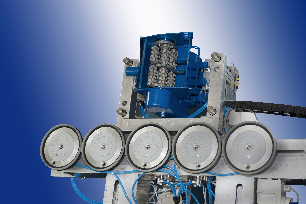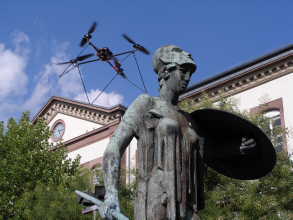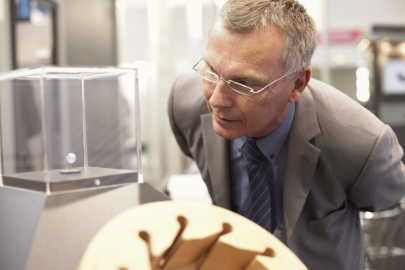The Karlsruhe Institute of Technology (KIT) will par-ticipate in the Hanover Trade Fair from April 20 to 24 with one central booth and several specialized booths. The central booth will focus on close-to-industry research in the fields of energy and nano- and microtechnologies. In addition, the KIT Business Club will present its activities and experts will give advice on chances of careers in top research.
Hall 2, booth C18: Karlsruhe Institute of Technology
With 1100 staff members, the KIT Energy Center is one of Europe’s largest energy research establishments. It pools the energy research conducted by Universität Karlsruhe and Forschungszentrum Karlsruhe as well as renowned cooperation partners. It is concentrated on developing an integrated concept for the energy mix of the future. The activities of the KIT Energy Center are organized in seven topics: Energy conversion, renewable energies, energy storage and distribution, efficient energy use, fusion technology, nuclear power and safety, and energy systems analysis. In the field of “Nuclear Power and Safety”, the model of the European light water reactor of the fourth generation will be presented at the Hanover Trade Fair. The high-performance light water reactor (HPLWR) is an innovative nuclear reactor, in which water at 250 bar is heated up in three steps from 280 to 500°C. Compared to today’s reactors, the advantages of the HPLWR are its high efficiency, its compact design due to the use of smaller plant components, and its improved economic efficiency.
The exhibits will also include a prototype of an autonomous manipulator, a type of carrier system for decontamination work (AMANDA). This carrier system developed by the KIT Institute for Technology and Management in Construction is controlled remotely and equipped with mills. Thanks to vacuum technology, it can be used without any auxiliary systems on various types of surfaces, i.e. in conventional buildings and in the nuclear sector.

Detailed view of AMANDA with mill and suction plates.
(Photo by: Markus Breig)
The AREVA Nuclear Professional School established jointly by KIT and AREVA NP GmbH trains young scientists and engineers to become experts in all fields of nuclear energy. The presentation of this first module of the KIT School of Energy completes this year’s focus of “Nuclear Power and Safety”.
The KIT NanoMicro Center will exhibit a ceramic microturbine at Hanover. In the collaborative research center “Micromolding”, the Institute for Materials Research is presently conducting research into microcomponents made of high-performance ceramics. The high-performance ceramic turbine developed is highly loadable and wear-resistant. It can be applied in many fields, among others in mechanical engineering, in process, energy, and medical engineering or in chemical industry.
The knowledge triangle of research, teaching, and innovation: In order to further enhance the innovative power of KIT and associated enterprises, the KIT Business Club was founded. Its main objective is to make the potentials and various contacts at the KIT accessible to individual industrial enterprises. At the Hanover Trade Fair, interested persons may contact our technology transfer experts. Experts from the KIT departments for personnel will inform about the chances of careers and qualification in top research and about current vacancies.
In addition, the KIT will present the following topics:
Hall 2, booth A35: Biomechanics Modeled on Nature
Based on nature as a model, Professor Mattheck and his team from the Institute for Materials Research developed and verified a simple method. This method is used to optimize technical components. Mostly, failure of a component starts with a crack. With the help of the new graphic “Method of Tension Triangles”, the risk of crack formation can be minimized and it is also possible to stop already existing cracks. A model demonstrates the load acting on the crack ends and crack stop in pressure zones.
Hall 13, booth C69: Superconductivity in Energy Technology
Scientists from the Institute of Technical Physics successfully transferred an old technology of cable winding for alternating currents, called Roebel bar, to superconducting high-current cables using technical tricks. The superconducting demonstration cable cooled in liquid nitrogen with a cross section of 30 mm2 conducts 2600 amperes of direct current. A cooper cable of the same power would require 50 to 100 times the cross section. The new superconductor offers entirely new possibilities of future applications in transformers, generators, and motors.
Hall 13, booth G74/1: Hydrogen Technology
The KIT Institute for Nuclear und Energy Technologies is developing instruments for the investigation and safety assessment of energy carriers like liquid and gaseous hydrogen. A demonstrator will be presented, which simulates real experiments with highly reactive hydrogen-air mixtures in pipelines.
Hall 22, booth A46: Air Quad
Together with microdrones GmbH, the Institute for Theoretical Electrical Engineering and Systems Optimization will present the Air Quad project. In the future, this mini intelligence helicopter shall detect obstacles and hazardous objects by laser, radar, and image processing. The objective is an autonomous mini helicopter for indoor and outdoor security and rescue services.

Der Aufklärungshelikopter AirQuad überfliegt den
Campus des KIT
(Foto: ITE)
The Karlsruhe Institute of Technology (KIT) is the merger of the Forschungszentrum Karlsruhe, member of the Helmholtz Association, and the Universität Karlsruhe. This merger will give rise to an institution of internationally excellent research and teaching in natural and engineering sciences. In total, the KIT has 8000 employees and an annual budget of 700 million Euros. The KIT focuses on the knowledge triangle of research – teaching – innovation.
The Karlsruhe institution is a leading European energy research center and plays a visible role in nanosciences worldwide. KIT sets new standards in teaching and promotion of young scientists and attracts top scientists from all over the world. More-over, KIT is a leading innovation partner of industry.

